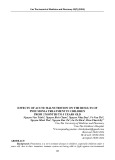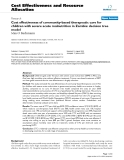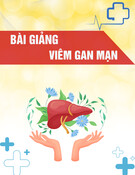
Can Tho Journal of Medicine and Pharmacy 10(7) (2024)
164
pathogens. Malnutrition affects the severity and outcome of pneumonia treatment. Objectives: 1) To
describe the results of pneumonia treatment in acute malnutrition children from 2 months to 5 years
old. 2) To determine the relationship between acute malnutrition and the results of pneumonia
treatment in children from 2 months to 5 years old. Materials and method: 174 children with
pneumonia with acute malnutrition from 2 months to 5 years old are receiving inpatient treatment
at Can Tho Children's Hospital, Disease group: Children diagnosed with pneumonia according to
the Ministry of Health 2014: Children with cough, fever accompanied by at least one of the signs of
rapid breathing according to age, chest indrawing (the lower part of the chest indents during
inhalation), or rales lung abnormalities (moisture rales, bronchial rales, crackles, etc.) [6]. AND
children diagnosed with acute malnutrition according to the Ministry of Health 2016: Children have
1 of 2 anthropometric conditions: arm circumference (MUAC) or weight for height (CN/CC) lower
than the normal threshold for age and gender (in which, severe malnutrition with MUAC<115 mm
or CN/CC<-3SD, moderate malnutrition with 115mm≤MUAC<125mm or -3SD≤CN/CC<-2SD)
[7]. Control group: children diagnosed with pneumonia without acute malnutrition. Disease control
research. Results: Some characteristics after treatment: antibiotic combination was 28.2%,
antibiotic change counted for 31.6%, respiratory support was 19.0%, intensive care unit transfer
was 6.9%, curative treatment results was 98.7%. There is a significant correlation between acute
malnutrition with pneumonia and the characteristics of treatment outcomes: severe pneumonia
(p<0.001), combined with antibiotics (p<0.001), respiratory support (p=0.012) and transfer to
Intensive Care Unit (p=0.017). Acute malnutrition with pneumonia was not significantly different
from changing antibiotics (p<0.625) and death after treatment (p=0.560). Conclusion: Acute
malnutrition is statistically significantly different from the severity of pneumonia, antibiotic
combination, respiratory support, and transfer to the Intensive Care Unit.
Keywords: pneumonia, level of pneumonia, acute malnutrition, children.
I. INTRODUCTION
Pneumonia is a very common disease in children, especially children under 5 years
old, due to the immature immune system not being able to fight against environmental
pathogens [1], [2]. The rate of malnutrition in Vietnamese children under 5 years old in
2017, according to the Institute of Nutrition, was 13.4% underweight, 23.8% stunting, and
7% wasting. These rates in the Mekong Delta are 11.6%, 22.5%, and 5.9%, respectively,
and in Can Tho City, these rates are 10.1%, 20.6%, and 3%, respectively [3]. Malnutrition
affects the severity and outcome of pneumonia treatment. More than half of children who
die from pneumonia are malnourished. Malnourished children are 3.8 times more likely to
get pneumonia than normal children [1], [4]. In fact, the rate of children suffering from
malnutrition and pneumonia is still very high and is related to each other [5]. Starting from
the above-mentioned bases, we conduct research with the following goals:
1) To describe the results of pneumonia treatment in acute malnutrition children
from 2 months to 5 years old.
2) To determine the relationship between acute malnutrition and the results of
pneumonia treatment in children from 2 months to 5 years old.
II. MATERIALS AND METHODS
2.1. Subjects/ Study participant
All children with pneumonia with acute malnutrition from 2 months to 5 years old
are receiving inpatient treatment at Can Tho Children's Hospital
Inclusion criteria:
Disease group: Children diagnosed with pneumonia according to the Ministry of
Health 2014: Children with cough, fever accompanied by at least one of the signs of rapid


























